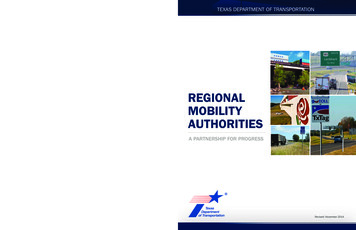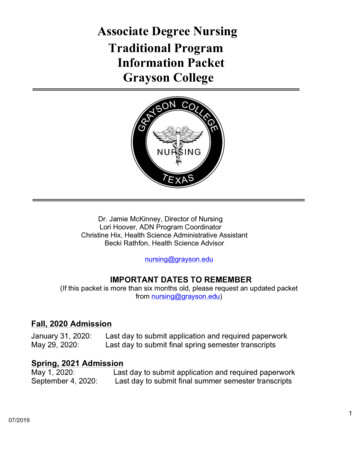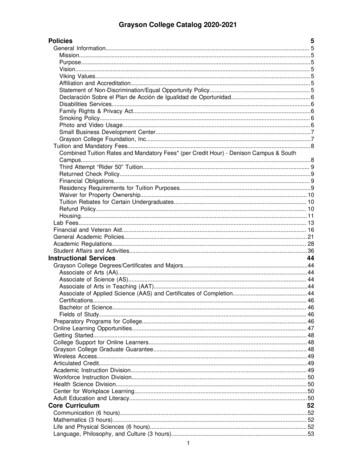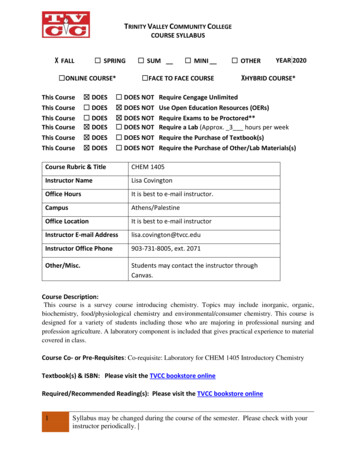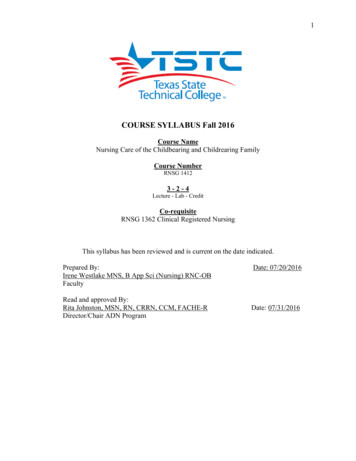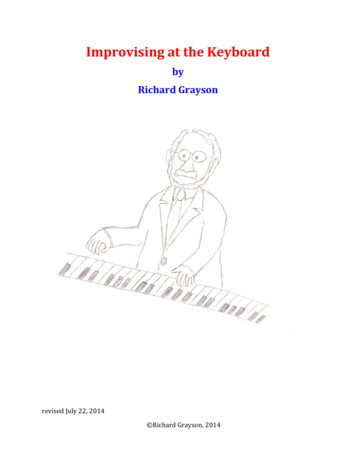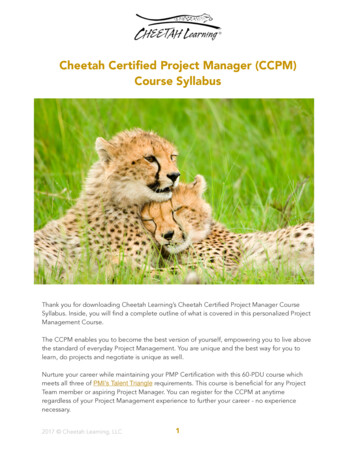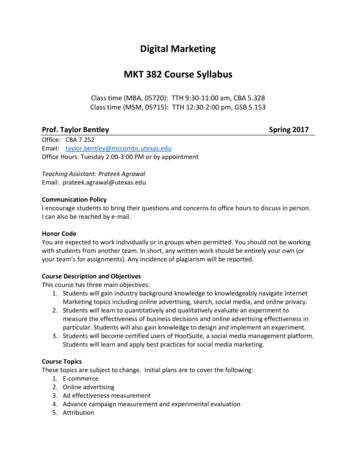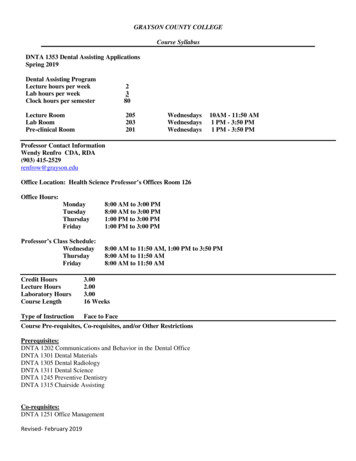
Transcription
GRAYSON COUNTY COLLEGECourse SyllabusDNTA 1353 Dental Assisting ApplicationsSpring 2019Dental Assisting ProgramLecture hours per weekLab hours per weekClock hours per semester2380Lecture RoomLab RoomPre-clinical Room205203201WednesdaysWednesdaysWednesdays10AM - 11:50 AM1 PM - 3:50 PM1 PM - 3:50 PMProfessor Contact InformationWendy Renfro CDA, RDA(903) 415-2529renfrow@grayson.eduOffice Location: Health Science Professor’s Offices Room 126Office Hours:MondayTuesdayThursdayFridayProfessor’s Class Schedule:WednesdayThursdayFriday8:00 AM to 3:00 PM8:00 AM to 3:00 PM1:00 PM to 3:00 PM1:00 PM to 3:00 PM8:00 AM to 11:50 AM, 1:00 PM to 3:50 PM8:00 AM to 11:50 AM8:00 AM to 11:50 AMCredit HoursLecture HoursLaboratory HoursCourse Length3.002.003.0016 WeeksType of InstructionFace to FaceCourse Pre-requisites, Co-requisites, and/or Other RestrictionsPrerequisites:DNTA 1202 Communications and Behavior in the Dental OfficeDNTA 1301 Dental MaterialsDNTA 1305 Dental RadiologyDNTA 1311 Dental ScienceDNTA 1245 Preventive DentistryDNTA 1315 Chairside AssistingCo-requisites:DNTA 1251 Office ManagementRevised- February 2019
DNTA 1347 Adv. Dental ScienceDNTA 1349 Radiology in the ClinicDNTA 1460 Clinical IDNTA 2230 Seminar for the Dental AssistantCourse Description – from collegeDNTA 1353. Dental Assisting Applications. (3-2-3). An expanded study of dental assisting techniques with emphasison four-handed dentistry and utilization of armamentarium for general practice and specialty procedures, (RW)A grade of “C” (75) or better is required for progression.Student Learning Outcomes1. Describe assisting a medically and physically compromised patient.2. Describe Endodontics, Periodontics, Oral and Maxillofacial Surgery, Pediatric Dentistry, and Orthodontics.3. Identify materials and instruments used in each of the specialties.4. Describe the role and responsibilities of the Dental Assistant in each of the specialties.5. Explain various post-operative instructions given to patients following endodontic treatment, surgical treatment, andorthodontic treatment.6. Describe preventive, interceptive and corrective orthodontics.7. Describe child behavior techniques.Course Learning Outcomes1. Assemble tray setups and materials for designated general and specialty procedures.2. Record patient chart information.3. Maintain clear field of vision including isolation techniques.4. Utilize chairside ergonomics.5. Apply OSHA and other regulatory agencies’ standards.Required Textbooks (ISBN # included) and Materials:1. Bird, Doni L., CDA, RDH, MA, and Debbie S. Robinson., CDA, MS, ModernDental Assisting. TwelfthEdition (2018). Elsevier/Saunders PublishersISBN: 978-0-323-43030-22. Microsoft Office software3. Wristwatch w/ second hand4. Pens, Pencils, Highlighters5. Paper, folder or notebook6. Student Uniforms7. Dental Assisting Student IDAdditional Resources Texas State Board of Dental Examiners website: http://www.tsbde.state.tx.us/Dental Assisting National Boards website: http://www.danb.orgRequired Assignments & Academic CalendarIn case of inclement weather, emergency closings, or other unforeseen disruptions to scheduled classes, studentmust log onto their Canvas accounts for directions on where or how to continue their coursework. PracticeCheck-offs are not graded or mandatory.Revised- February 2019
The Instructor also strongly suggests that each student join the class GROUP ME app on their phone.The schedule listed below is subject to change with fair notice from the professor. Changes will be announced in theclassroom and through the Canvas course.WeekDateDNTA 1353 Dental Assisting Application Course Schedule Spring 2019Topics, Reading, Assignments11/1621/2331/3042/652/13Revised- February 2019Review SyllabusLecture Chapter 56 Oral & Maxillofacial SurgeryLab: Identify & Discuss Oral Surgery Instruments Demonstrate and Practice following skills56-1 Preparing a Sterile Field for Instruments and Supplies56-2 Performing a Surgical Scrub56-3 Performing a Sterile Gloving Other Clinical Skills/ Comp. Lab/ Study Groups Clean lab & clinic following infection control protocolTEST, SKILL CHECK OFFS AND PRACTICAL C- 56 & 54 will be on 2/6Lecture : Videos Oral Surgery / In Class AssignmentLab: Study Oral Surgery Instruments Demonstrate & Practice following skill check offs56-4 Procedure steps in Forceps Extraction56-7 Suture Placement & Removal56-8 Giving Pre & Post op Instructions56-9 Treatment of Alveolitis Practice other skills/ Comp. Lab/ Study Groups Clean lab & clinic following infection control protocolLecture: Chapter 54 EndodonticsLab: Identify & Discuss Endodontic Instruments Demonstrate & Practice the following Skill Check offs54-1 Assisting in Electric Pulp Vitality Test54-2 Procedure Steps for Root Canal Therapy Practice other clinical skills/ comp. lab/ study groups Clean lab & clinic following infection control protocolLecture: Endodontics Videos / In Class AssignmentLab: TEST and PRACTICAL C 56 & C 54 SKILL Check Offs for C 56 & C 54 Practice other clinical skills/ comp. lab/ study groups Clean lab & clinic following infection control protocolLecture: C - 60 Orthodontics
Lab: 62/2072/2783/693/13Identify & Discuss Orthodontic InstrumentsDemonstrate and Practice the following Skill check offs60-2 Placing and Removing Elastomeric Ring Separators60-6 Procedural Steps for Placing and Removing Ligature Ties Practice other clinical skills/ comp.lab/study groups Clean lab and clinic following infection control protocol Test, Skill Check off (C 60) and Practical for C 60 & C 55 will be on 3/6Lecture: Videos on Orthodontic Procedures / In Class AssignmentLab: Study Orthodontic Instruments Practice the following skill check offs60-2 Placing and Removing Elastomeric Ring Separators60-6 Procedural Steps for Placing and Removing Ligature Ties Practice other clinical skills/ comp.lab/ study groups Clean lab and clinic following infection control protocolLecture: C-55 PeriodonticsLab: Skills C 55 Assisting with a Periodontal Procedure Practice other clinical skills Clean lab and clinic following infection control protocolLecture: C- 55 Periodontics Videos/ In Class AssignmentLab: TEST and PRACTICAL C 60 & C 55 Skill Check Offs for C 60 & C 55 Practice other clinical skills Clean lab and clinic following infection control protocolSPRING BREAK / NO CLASSESLecture: C- 57 Pediatric DentistryLab:103/20 Revised- February 2019Skills C 57 Discuss and Record Procedural steps for the following procedures;Skills C 57 Assisting in Pulpotomy of a Primary ToothSkills C 57 Assisting in Placement of a Stainless Steel CrownSkills C 57 Practice other clinical skills/ comp lab/ study groupsClean lab and clinic following infection control protocolTEST & SKILL CHECK OFF C 57 Pediatric Dentistry is next week (NOPRACTICAL)
Lecture: C-57 Pediatric Dentistry Videos on Procedures/ In Class AssignmentLab:113/27 124/3134/10144/17154/2416TBATBA TEST C 57 Pediatric Dentistry (NO PRACTICAL) Complete C 57 SkillsPractice other clinical skills/ comp lab/ study groupsClean lab and clinic following infection control protocolLecture: C-50 Fixed ProsthodonticsLab: Skills C 50-Discuss and Record Procedural Steps forAssisting with a Crown or Bridge Skills C 50 Cementing a Crown or Bridge Practice other clinical skills Computer lab/ study groups Clean lab and clinic following infection control protocolTEST C 50 NEXT WEEK ( NO PRACTICAL)Lecture: Fixed Prosthodontics Videos/ In Class AssignmentLab: TEST C 50( NO PRACTICAL) Complete Skills C 50 Practice other clinical skills Computer lab/ study groups Clean lab and clinic following infection control protocolLecture: C 52 Removable ProsthodonticsLab: Skills C 52 Assisting in Delivery of a Full Denture Practice other clinical skills Computer lab/ study groups Clean lab and clinic following infection control protocolLecture: Removable Prosthodontics/In Class AssignmentLab: TEST C 52 (NO PRACTICAL) Complete C 52 Skills Practice other clinical skills Computer lab/ study groups Clean lab and clinic following infection control protocolFinal Exam 8-10 AMNitrous Oxide Certification & RDA Review and ExamChapter 56 Oral and Maxillofacial SurgeryRevised- February 2019
Chapter Outline Indications for Oral and Maxillofacial Surgery The Oral Surgeon The Surgical Assistant The Surgical Setting Specialized Instruments and Accessorieso Elevatorso Forcepso Surgical Curretteo Rongeuro Bone Fileo Scalpelo Hemostato Needle Holdero Surgical and Suture Scissorso Retractorso Mouth Propso Chisel and Malleto Rotary Instruments Surgical Asepsis: Sterile Field Surgical Preparation Surgical Procedures Postoperative Care Postsurgical ComplicationsExpected Learning Outcomes (Objectives)1. Pronounce, define, and spell the Key Terms.2. Describe the specialty of oral and maxillofacial surgery.3. Discuss the role of an oral surgery assistant.4. Identify specialized instruments used for basic surgical procedures.5. Discuss the importance of the chain of asepsis during a surgical procedure.6. Demonstrate competency in preparing a sterile field.7. Demonstrate competency in performing a surgical scrub.8. Demonstrate competency in performing sterile gloving.9. Describe surgical procedures typically performed in a general practice.10. Demonstrate ability to assist in a simple extraction.11. Demonstrate ability to assist in suture placement.12. Demonstrate performing suture removal.13. Demonstrate postoperative care given to a patient after a surgical procedure.14. Discuss with a patient possible complications resulting from surgery.15. Demonstrate competency in assisting in the treatment of alveolitis (dry socket).Chapter 54 EndodonticsChapter Outline Causes of Pulpal Damage Symptoms of Pulpal Damage Endodontic Diagnosis Endodontic Procedureso Pulp cappingo PulpotomyRevised- February 2019
o PulpectomyInstruments and AccessoriesMedicaments and Dental Materials in EndodonticsOverview of the Root Canal TherapySurgical EndodonticsExpected Learning Outcomes (Objectives)1. Pronounce, define, and spell the Key Terms.2. Describe the diagnostic testing performed for endodontic diagnosis.3. Demonstrate assisting in various diagnostic testing performed for endodontic diagnosis.4. List the conclusions of the subjective and objective tests used in endodontic diagnosis.5. Demonstrate competency to assist in electric pulp vitality test.6. Describe diagnostic conclusions for endodontic therapy.7. List the types of endodontic procedures.8. Discuss the medicaments and dental materials used in endodontics.9. Provide an overview of root canal therapy.10. Demonstrate correct tray set-up for assisting in root canal therapy.11. Describe surgical endodontics and how it affects treatment.Chapter 60 OrthodonticsChapter Outline Benefits of Orthodontic Treatment The Orthodontist and Orthodontic Assistant The Orthodontic Office Understanding Occlusion Malocclusiono Class I Malocclusiono Class II Malocclusiono Class III Malocclusiono Malaligned Teeth Management of Orthodontic Problems Orthodontic Records and Treatment Planning Case Presentation Specialized Instruments and Accessories Orthodontic Treatment Treatment Options Adjustment Visits Oral Hygiene and Dietary Instructions Headgear Completed Treatment: RetentionRevised- February 2019
Expected Learning Outcomes (Objectives)1. Pronounce, define, and spell the Key Terms.2. Describe the environment of an orthodontic practice.3. Describe the types of malocclusion.4. Discuss corrective orthodontics, and describe what type of treatment is involved.5. List the types of diagnostic records that are used to assess orthodontic problems.6. Describe the components of the fixed appliance.7. Demonstrate placement and removal of elastomeric ring separators.8. Demonstrate competency in assisting in the fitting and cementation of orthodontic bands.9. Demonstrate competency in assisting in the direct bonding of orthodontic brackets.10. Demonstrate competency in assisting in placement of an arch wire.11. Demonstrate competency to place and remove ligature ties.12. Demonstrate competency in to place and remove elastomeric ties.13. Describe the use and function of headgear.14. Describe ways to convey the importance of good dietary and oral hygiene habits in the practice of orthodontics.15. Demonstrate explaining oral hygiene and dietary instructions to orthodontic patients.Chapter 55 PeriodonticsChapter Outline The Periodontal Examinationo Medical and Dental Historyo Dental Examinationo Mobilityo Oral Tissues and Supporting Structureso Periodontal Probingo Bleeding Indexo Occlusal Adjustmento Radiographic AnalysisPeriodontal Instrumentso Probeso Explorerso Scalers & Fileso Curetteso Surgical Kniveso Pocket MarkersHand Scaling and Ultrasonic Scalingo Ultrasonic ScalerNonsurgical Periodontal Treatmento Dental Prophylaxiso Scaling and Root Planingo Gingival Curettageo Antimicrobial and Antibiotic Agentso Locally Delivered AntibioticsSurgical Periodontal TreatmentRevised- February 2019
o Advantages and Disadvantageso Remaining Boneo Excisional Surgeryo Incisional Surgeryo Osseous Surgeryo Crown Lengtheningo Soft Tissue Graftso Postsurgical Patient Instructionso Periodontal Surgical Dressingso Esthetic and Plastic Periodontal Surgery Lasers in Periodonticso Advantages of Laser Surgeryo Laser SafetyExpected Learning Outcomes (Objectives)1. Pronounce, ,define, and spell the key terms.2. Describe the role of the dental assistant in a periodontal practice.3. Explain the procedures necessary for a comprehensive periodontal examination, including the following: Describe the early signs of periodontal disease Describe the role of radiographs in periodontal treatment.4. Identify and describe the instruments used in periodontal therapy.5. Discuss hand scaling and ultrasonic scaling, including the following; Use of the ultrasonic scaler6. Describe the types of nonsurgical periodontal treatment.7. Discuss the types of surgical periodontal treatment , including the following: Explain the purpose of crown lengthening. Describe the purpose of soft tissue grafts. Describe the postsurgical patient instructions. Identify the indications for placement of periodontal surgical dressings. Describe the technique for proper placement and removal of periodontal surgical dressings Name the types of periodontal plastic surgeries.8. Discuss the use of lasers in periodontics.Chapter 57 Pediatric DentistryChapter Outline The Pediatric Dentist and Dental Assistant The Pediatric Dental Office The Pediatric Patiento Erikson’s Stages of Developmento Behavior Management Patients With Special Needs Diagnosis and Treatment Planning Preventive Dentistry for Children Pediatric Procedures Pediatric Procedures Dental Trauma Child AbuseExpected Learning Outcomes (Objectives)1. Pronounce, define, and spell the Key Terms.2. Describe the appearance and setting of a pediatric dental office.Revised- February 2019
3.4.5.6.7.8.9.10.11.List the stages of childhood from birth through adolescence.Discuss specific behavior techniques that work as positive reinforcement when one is treating children.Describe why children and adults with special needs are treated in a pediatric practice.Describe what is involved in the diagnosis and treatment planning of a pediatric patient.Discuss the importance of preventive dentistry in pediatrics.Demonstrate giving oral hygiene and nutritional instructions to patients and patient’s caregiver.Demonstrate placement of fluoride treatment on pediatric patient and/ or special needs patient.Demonstrate correct post-fluoride treatment instructions.List the types of procedures that are performed for the pediatric patient compared with those performed to treatpatients with permanent teeth.12. Demonstrate ability to assist in a pulpotomy of a primary tooth.13. Demonstrate competency in assisting in the placement of a stainless steel crown.14. Describe the most common types of dental trauma in children and the basic knowledge a dental assistant should haveregarding possible child abuse.Chapter 50 Fixed ProsthodonticsChapter Outline: Plan of Care Indirect Restorationso Inlays and Onlayso Veneerso Crownso Fixed Bridge Role of the Dental Laboratory Techniciano Laboratory Prescriptiono Laboratory Working Days Overview of a Crown Procedureo Shade Selectiono Tooth Preparationo Retention Aids for Crownso Gingival Retraction and Tissue Managemento Final Impression and Bite Registrationo Provisional Coverageo Delivery Appointmento Provisional Placement of a Permanent Casting Overview of a Bridge Procedureo Preparation Appointmento Try-In and Cementation Appointmento Patient Instructions Computer-Assisted RestorationsExpected Learning Outcomes (Objectives)1. Pronounce, define, and spell the key terms.2. List indications for and contraindications to a fixed prosthesis.3. Discuss indirect restorations, including the following: Describe the differences among inlays, onlays, veneer crowns, and full crowns. Describe the uses of porcelain for fixed prosthodontics. Identify the components of a fixed bridge.4. Identify the role of the laboratory technician and the steps for a diagnostic workup.5. Explain a crown procedure, including the following: Describe the preparation and placement of a cast restoration. Discuss the uses of core buildups, pins, and posts in crown retention.Revised- February 2019
Describe the use of retraction cord before taking a final impression. Describe the function of provisional coverage for a crown or fixed bridge.6. Explain a bridge procedure, including the home care instructions for a permanent fixed prosthesis.7. Describe the steps when using a CAD/CAM system.Chapter 52 Removable ProsthodonticsChapter Outline: Factors influencing the Choice of a Removable Prosthesiso Extraoral Factorso Intraoral FactorsRemovable Partial Dentureo Components of a Partial Dentureo Appointment Sequencing for a Partial Dentureo Home Care Instructionso Components of a Full Dentureo Appointment Sequencing for a Full Dentureo Home Care Instructionso What to Expect the First MonthImmediate Dentureso Constructiono Surgical Templateo PlacementOverdenturesDenture Adjustment and Reliningo Tissue Conditionerso Impressiono DeliveryDenture RepairsDenture DuplicationExpected Learning Outcomes (Objectives)1.2.3.4.5.6.7.8.9.Pronounce, define, and spell the key terms.Differentiate between a removable partial and a full denture.Identify factors that influence the choice for removable partial and full dentures.Discuss removable partial dentures, including the following: List the components of a partial denture. Describe the appointment sequence needed for the proper construction of a removable partial denture. Identify home care instructions for removable partial dentures.Discuss removable full (complete) dentures, including the following : List the components of a full denture Describe the appointment sequence needed for the proper construction of a full denture. Identify home care instructions for removable full dentures. Explain what to expect the first month of having a denture.Discuss the construction, surgical template, and placement of an immediate denture.Discuss the process of constructing overdentures.Discuss the process of denture adjustment and relining.Discuss denture repair and duplication.Revised- February 2019
Instructional MethodsFace to FaceStudents will be required to complete laboratory assignments/competencies. These will include, but are not limitedto alginate impressions, pouring up in Gypsum, trimming models, fabricating bleach trays and occlusal guards,practicing skills, studying instruments for practical, in class activities, interactive discussions and homeworkassignments.FabricationsStudents will fabricate 1 bleach tray and 1 occlusal guard utilizing impressions taken on their radiology volunteer.The student will choose
GRAYSON COUNTY COLLEGE Course Syllabus DNTA 1353 Dental Assisting Applications Spring 2019 Dental Assisting Program Lecture hours per week 2 . 54-1 Assisting in Electric Pulp Vitality Test 54-2 Procedure Steps for Root Canal Therapy
